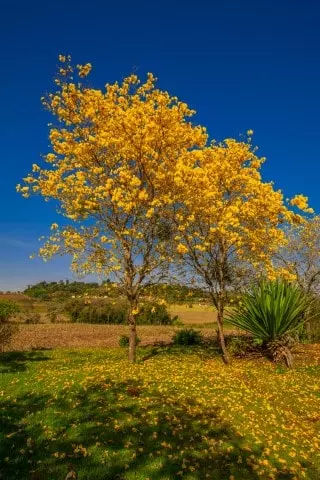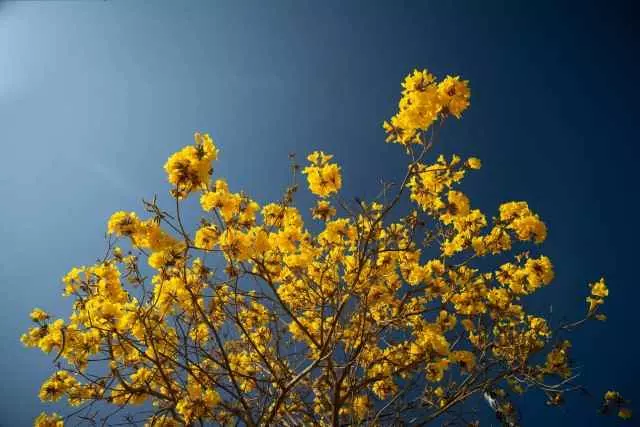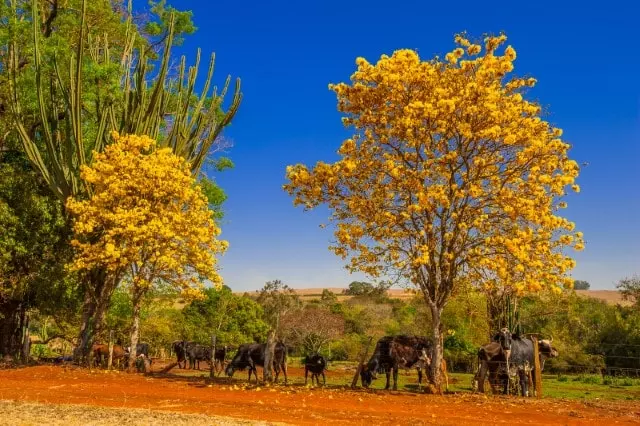Ipe is the National Flower of Brazil, and scientifically it is called Handroanthus serratifolius. It is also known as yellow lapacho or yellow ipe, and until the beginning of the 20th century, it was included among the Tecomas.
The Ipe is a medium-sized tree, which stands out on the slopes of the different mountains in Brazil. It has a trunk with robust, cracked bark, strong branches, and compound leaves of up to seven leaflets.
It is a tree that blooms in October with beautiful, abundant, intensely colored yellow flowers.
The ipê tree is highly valued in Brazil and it is common to see it emerging on the horizon. The people of Brazil are also deeply rooted in their traditions and customs, so respect for their national symbols is highly regarded around the world.
Table of Contents
Distribution and Habitat National Flower of Brazil
Its distribution is in dry and rough forests. Being a strong tree, it withstands various temperatures, so the intense sun will not wilt it.
Ipê Flower Usage
Brazil is a country full of colors, so the use of the Ipê flower in daily life is common, for example, in its famous carnivals, this flower is part of the decoration of its wonderful floats and parades.
It predominates at special events as a place ornament, so you can find it in many decorations.
This flower is also very popular as an ornament on cakes, because its petals are large and wide, giving it brightness, and the yellow color makes it more striking and elegant.
In school ceremonies in Brazil, it is very common to use the Ipê flower, because it is the national flower. The children perform traditional dances accompanied by crowns prepared with this flower.

It is also representative of the carioca culture to include the ipê flower in various church ceremonies, so it is not difficult to find bridal bouquets made with this type of flower, as well as to decorate the pillars of their religious saints.
Another of the celebrations where this flower is predominantly used is the traditional festival held every February 2nd to honor “Iemanjá, goddess of the sea”, who, according to belief, is the protector of the sea and its sailors.
Legend has it that if a fisherman offers his daily labor when he goes out fishing, the day will be fruitful, and he will be protected throughout the fishing trip. In return, he must honor her by sharing part of the load with those in need and also take her for a walk each February.
Characteristics and Uses of Ipê Wood
The tree that gives Brazil’s national flower has a special wood, excellent for construction work, in fact, it is a favorite of professionals, thanks to its durability and resistance.
In Brazil, it is very well known and those who have the opportunity to acquire this wood for their constructions will be well-favored. It is worth noting that it is not considered a type of flora in danger of extinction, but it is very much in demand.

Houses, roofs, and floors can be built with the wood of this tree. However, the cost is a bit high compared to other materials.
This tree can also be found in other countries, such as Argentina, Bolivia, and Peru.
Although it is a very showy flower and becomes strong, it cannot be grown at home, it can only be used as a decorative species. Unless you have the space to plant this tree.
Healing Properties of the National Flower of Brazil
According to studies, it is rich in anti-hemorrhagic and anti-inflammatory substances that are beneficial to the body.
It can also be used as a treatment for snakebites, as it reduces the edema and toxicity left by the venom.
Because of its anti-inflammatory effects, it can be drunk as tea three times a day to reduce swelling.
On the other hand, it is believed that this tree can be used to fight cancer, using its bark, and also as a fungicide. As the national flower of Brazil, the Ipê has the cultural respect of all its citizens to protect it and make its species prevail.
If you are interested in the national flowers of the countries we recommend you our articles about the National Flower of Puerto Rico and National Flower of Colombia.

